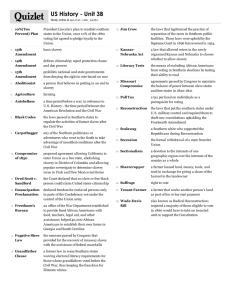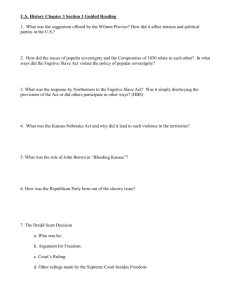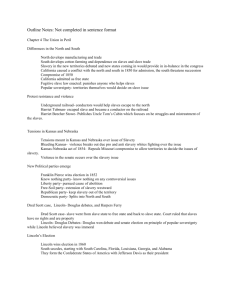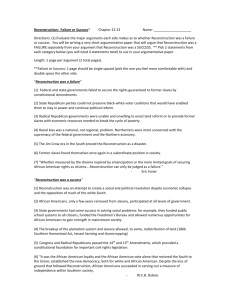Civil War - Anderson School District Five
advertisement
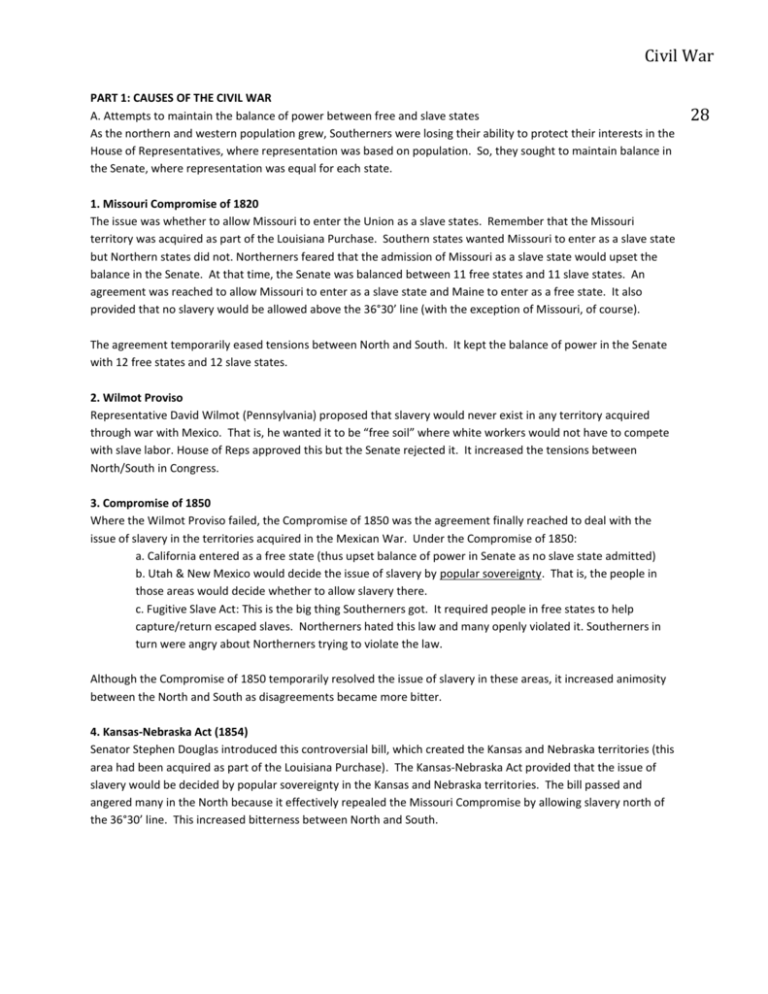
Civil War PART 1: CAUSES OF THE CIVIL WAR A. Attempts to maintain the balance of power between free and slave states As the northern and western population grew, Southerners were losing their ability to protect their interests in the House of Representatives, where representation was based on population. So, they sought to maintain balance in the Senate, where representation was equal for each state. 1. Missouri Compromise of 1820 The issue was whether to allow Missouri to enter the Union as a slave states. Remember that the Missouri territory was acquired as part of the Louisiana Purchase. Southern states wanted Missouri to enter as a slave state but Northern states did not. Northerners feared that the admission of Missouri as a slave state would upset the balance in the Senate. At that time, the Senate was balanced between 11 free states and 11 slave states. An agreement was reached to allow Missouri to enter as a slave state and Maine to enter as a free state. It also provided that no slavery would be allowed above the 36°30’ line (with the exception of Missouri, of course). The agreement temporarily eased tensions between North and South. It kept the balance of power in the Senate with 12 free states and 12 slave states. 2. Wilmot Proviso Representative David Wilmot (Pennsylvania) proposed that slavery would never exist in any territory acquired through war with Mexico. That is, he wanted it to be “free soil” where white workers would not have to compete with slave labor. House of Reps approved this but the Senate rejected it. It increased the tensions between North/South in Congress. 3. Compromise of 1850 Where the Wilmot Proviso failed, the Compromise of 1850 was the agreement finally reached to deal with the issue of slavery in the territories acquired in the Mexican War. Under the Compromise of 1850: a. California entered as a free state (thus upset balance of power in Senate as no slave state admitted) b. Utah & New Mexico would decide the issue of slavery by popular sovereignty. That is, the people in those areas would decide whether to allow slavery there. c. Fugitive Slave Act: This is the big thing Southerners got. It required people in free states to help capture/return escaped slaves. Northerners hated this law and many openly violated it. Southerners in turn were angry about Northerners trying to violate the law. Although the Compromise of 1850 temporarily resolved the issue of slavery in these areas, it increased animosity between the North and South as disagreements became more bitter. 4. Kansas-Nebraska Act (1854) Senator Stephen Douglas introduced this controversial bill, which created the Kansas and Nebraska territories (this area had been acquired as part of the Louisiana Purchase). The Kansas-Nebraska Act provided that the issue of slavery would be decided by popular sovereignty in the Kansas and Nebraska territories. The bill passed and angered many in the North because it effectively repealed the Missouri Compromise by allowing slavery north of the 36°30’ line. This increased bitterness between North and South. 28 Civil War 5. Bleeding Kansas (1855-1856) After the passage of the Kansas-Nebraska Act, many pro-slavery and abolitionist forces rush into Kansas so that they could vote for their side (popular sovereignty). Violence broke out between these forces. John Brown (an abolitionist) was responsible for much of the violence. 200+ people killed. B. Abolitionist Movement Abolitionists were those who wanted to end all slavery in the United States. The abolitionist movement was very active during the Antebellum Era (1820s-1860s). They wanted to end slavery everywhere but many of the key battles were over whether slavery should be allowed to expand into the territories. The abolitionists had the effect of increasing tensions between North and South. Their efforts were not immediately successful as slavery was not ended until the end of the Civil War. a. Underground Railroad • Harriet Tubman was a key leader: She was escaped slave; abolitionist • Returned to south many times. Led Underground Railroad. Not actual RR. It was network of people helping slaves escape to North/Canada. Helped many fugitive slaves. b. Uncle Tom’s Cabin (1852) • Harriet Beecher Stowe (author) wrote this novel, which told of the hardships of slavery. This made slavery not just a political issue but also a moral one. It exposed many Northerners to the evils of the slavery for the first time. Although most people in the North were not abolitionists, this book caused many to start supporting abolition. Of course, the book angered Southerners, who saw it as an attack on their way of life. c. John Brown’s Raid on Harpers Ferry, VA (1859) • • • John Brown & his men planned to raid the arsenal at Harpers Ferry & equip local slaves with weapons to revolt with. US Marines under the command of Col Robert. E Lee put down the rebellion. John Brown is tried for high treason and hanged = becomes martyr for the abolitionist cause. Struck fear in the hearts of Southerners, who feared that many Northerners supported Brown’s position. C. States’ Rights vs. National Authority In 1854, the Republican Party was established. It brought together a coalition of people from other parties. They did not call for the immediate abolition of slavery. What they wanted was for the new territories to be “free soil,” where slavery would not be allowed. The 1857 decision Dred Scott v. Sanford reassured Southerners while angering Northerners. -Dred Scott, slave from Missouri, was taken north of the 36º30’ line & lived in Illinois & Wisconsin (free territories). Returned with master to Missouri. When master died; he filed lawsuit for his freedom; claiming he was free because he had lived in free territories. The Supreme Court, led by Justice Roger Taney held that slaves were not citizens but instead were property. Declared that it was unconstitutional for slave owners to be deprived of their property (slaves); declared Missouri Compromise unconstitutional. Stated Congress could not ban spread of slavery because doing so interfered with slaveholders’ property rights. 29 Civil War 30 Election of 1860: Abraham Lincoln (Republican) won the election. Country was deeply divided. Northern and Southern democrats supported different candidates. The division among democrats helped Lincoln win. Lincoln and Republicans were NOT abolitionists. They supported “free soil”, i.e., not allowing slavery in the territories. Southerners feared that Lincoln would not only attempt to stop slavery from spreading into the territories but would also try to end slavery in the South. Thus, Southerners believed that the federal government would interfere with their “states’ rights,” in particular their right to allow slavery. The Southern states felt that it was their right to leave the Union. South Carolina was the first state to secede (leave the Union), and other states followed. The Confederate States of America (CSA) was formed in Feb 1861. PART 2: THE CIVIL WAR A. Southern Secession WHY: Southerners saw Lincoln’s election as a threat to slavery. They saw secession as their last chance to save their way of life. Southerners viewed the issue of slavery as an issue of state’s rights. President Lincoln’s goal was to preserve the Union. WHAT: South Carolina seceded on Dec. 20, 1860. Mississippi, Florida, Alabama, Georgia, Louisiana, Texas. Later joined by VA, ARK, TN, NC RESULT: These states formed the Confederate States of America PRESIDENT: Jefferson Davis elected President of the Confederacy Union Advantages -More manpower, factories, food production, and an extensive railroad system -Lincoln as a leader and an established government/military. Lincoln more effective than Jefferson Davis. -Greater population Confederate Advantages -Cotton and trading relationship with Great Britain -first rate generals (like Robert E. Lee) and strong military tradition -soldiers who were highly motivated because they were defending their homeland, way of life, right to govern selves (states’ rights) -Soldiers were more familiar with the home terrain where many battles were fought Civil War B. Key battles and their importance EASTERN THEATER BATTLE (1) Fort Sumter (April 12, 1861). Fort Sumter (SC) remained in Union hands. Confederacy demanded that Lincoln surrender fort or face attack. Lincoln sent supply ships in to the fort but no soldiers or munitions. Confederates opened fire on Fort Sumter. (2) First Battle of Bull Run (First Manassas) (July 1861) (2) Second Battle of Bull Run (Second Manassas) (August 1862) (3) Antietam (September 1862): Lee moved towards Washington. A Union soldier found Lee’s plans wrapped around a bunch of cigars. The armies fought at a creek in Maryland called Antietam. Bloodiest single-day battle in American history. (4) Gettysburg: (July 1863) Lee pressed into North after winning a key battle at Chancellorsville, VA. 31 IMPORTANCE AND RESULTS Importance: First shots of war. Winner: South. Consequences: North and South mobilize for war. Importance: First major land battle Winner: South. Humiliating defeat for North. If better organized, Confederates could have invaded Washington, DC (30 miles) Consequences: -Forced Lincoln to adopt the Anaconda Plan (splitting the South at the Mississippi River and taking the capital at Richmond; cutting off supply lines) Importance: One of Gen. Robert E. Lee’s (South) first major victories. Ended Union’s hopes of invading Richmond. Winner: South Consequences: Lee decides to invade North. Importance: Bloodiest single-day battle in US history. South had to retreat-couldn’t advance into North. Winner: Tie but South had to retreat Consequences: Gave President Lincoln the opportunity to issue Emancipation Proclamation. Importance: Ended South’s hopes of invading North. Winner: North Consequences: 4 months later Lincoln gave Gettysburg Address at cemetery on sight of battlefield. Address showed Lincoln’s desire to see Union survive/country reunited. WESTERN THEATER (5) Vicksburg: May-July 1863 Ulysses S. Grant laid siege to Vicksburg for two months until town surrendered. (6) Sherman’s March to the Sea: May-December 1864 William T. Sherman captured Atlanta in Battle of Atlanta in Sept 1864. Burned city and continued march to sea, destroying bridges, factories, and railroad lines. Importance: Divided South at the Mississippi River. Winner: North, led by Ulysses S. Grant. Consequences: Gave new hope to the North that war could be won. Importance: Critical in ending the war and demoralizing the South. Winner: North. Consequences: Gave people of the North hope that the end of the war was in sight. This helped Lincoln be reelected. C. Summary of war strategies: North-Anaconda Plan. Split the South at the Mississippi River and take the Confederate Capital of Richmond. Blockade southern ports-keep goods from coming in from Great Britain. After Ulysses S. Grant won at Vicksburg, Lincoln named him as commander of the northern forces. He adopted a “total war” strategy—meaning that they would fight not only the South’s armies but its civilian population as well. Civilians supplied the troops and the will Civil War of the people kept the war going. He sought to demoralize them. This can best be seen in Sherman’s March to the Sea. South-Seek support from Great Britain and defend the South until they received aid from Britain or the North got tired of the war effort. Confederacy made two unsuccessful attempts to invade the North (Antietam and Gettysburg). D. Emancipation Proclamation Became effective January 1, 1863- Freed slaves who were behind Confederate lines outside Union control. Announced Emancipation as a military measure against the South. Had to be careful not to alienate border slave states that had not left the Union. So, he only made it apply in areas that were still in rebellion against the Union & not under Union control. It is important to remember that this did not free slaves that were in Union states. Lincoln announced the EP in the fall of 1862, months before it took effect. This gave Southern states a chance to make peace and keep their slaves. In reality, the Southern states were unlikely to listen to the listen to the President of the United states and were not going to voluntarily surrender their slaves. Once word of the EP got out, however, many slaves escaped to the Union lines and freedom. Freedom for all slaves was not realized until after the war (13th Amendment). EP allowed free blacks to enlist in Union army. Many welcomed the opportunity to fight to end slavery. (Example: 54th Massachusetts-made courageous assault on Fort Wagner in Charleston.) In general African American soldiers were poorly supplied and paid less than white soldiers and served in segregated units. By making the liberation of slaves a goal of the war, Lincoln made it impossible for British (who strongly opposed slavery at this point) to continue to support Southern war effort E. End of War Lee and Grant met to arrange surrender on April 9, 1865 at Appomattox Court House. F. Effect of war on democracy: Preserved Union while liberating slaves. Although secession failed, the states’ rights idea was never defeated and is still occasionally used in debating controversial political topics. It was raised during the modern Civil Rights Era, for example. 32 Civil War Part 3: Reconstruction Notes Reconstruction (1865-1877) refers to (1) the period during which the United States began to rebuild after the Civil War and (2)the process used to readmit defeated Confederate states to Union. The readmission of Southern states was the main goal. Northern Republicans did not see it as their job to rebuild the South. They wanted Southern states to re-establish full participation in the South, including liberation of their slaves. Northerners believed it was the job on local governments and individuals to rebuild the South. *Republicans dominated southern governments in the Reconstruction years. I. PRESIDENTIAL RECONSTRUCTION A. Lincoln: President Lincoln’s Plan =lenient on South “10% PLAN” Pardon to all but the highest ranking military and civilian Confederate officers. When 10% of the voting population in the 1860 election had taken an oath of loyalty and established a government, it would be recognized. B. Johnson When Lincoln was assassinated, his successor, Andrew Johnson, announced his own plan. Offered amnesty upon simple oath to all except Confederate civil and military officers and those with property over $20,000 (they could apply directly to Johnson) In new constitutions, they must accept minimum conditions rejecting slavery and secession. II. Congressional Reconstruction A. 13th Amendment Ratified in December, 1865. Outlawed slavery Neither slavery nor involuntary servitude, except as punishment for crime whereof the party shall have been duly convicted, shall exist within the United States or any place subject to their jurisdiction. Congress shall have power to enforce this article by appropriate legislation. B. Black Codes Before Congress met to set up its Reconstruction plan, Southern states passed laws that discriminated against blacks, “black codes,” which practically made them slaves again. Southern citizens and vigilante groups engaged in violence against freedmen. They elected former Confederate officers and officials to Congress. 33 Civil War C. Congressional Reconstruction In December 1865, the newly elected Southern legislators arrived in Washington to take their seats. Congress refused to admit the new Southern legislators. Due to Southern resistance to Reconstruction efforts, Republicans in Congress believed that more should be required for Southern states to re-gain full participation in the Union. Many were alarmed at the violence against freedmen in the South. In 1866, Congress voted to enlarge the Freedman’s Bureau (agency designed to aid freed slaves and others) and passed the Civil Rights Act of 1866, that law gave African Americans citizenship and forbade states from passing discriminatory laws (black codes), that severely restricted African American lives. President Johnson shocked everyone when he vetoed both the Freedman’s Bureau Act and the Civil Rights Act. In Mid-1866, Congress overrode the president’s vetoes of the Civil Rights Act and Freedman’s Bureau Act. Later, Congress would move to impeach President Johnson so that he could not interfere with its Reconstruction plans. D. The 14th Amendment The 14th Amendment prevented states from denying rights and privileges to any U.S. citizen, now defined as “all persons born or naturalized in the United States.” This protected the rights of African Americans (“equal protection under the law” for African Americans) and granted them citizenship. This invalidated the Dred Scott decision. E. “Radical” Reconstruction The Radical Republicans (name given to them by those who disapproved their approach to Reconstruction) gained control of Congress in the elections of 1866. Congress passed the Reconstruction Act of 1867. The Reconstruction Act divided the former Confederate states into five military districts. The states were required to grant African American men the vote and to ratify the 14th Amendment in order to reenter the Union. Once again, Johnson vetoed the new plan, but Congress overrode the veto. F. Introduction of 15th Amendment In the 1868 presidential elections, Civil War hero Ulysses S. Grant won. After the election, the Radical Republicans introduced the Fifteenth Amendment, which says that no one can be kept from voting because of “race, color, or previous condition of servitude.” The amendment was ratified in 1870. Gave right to vote to African American males. With protection from Union troops, African Americans began voting and many were elected to office. Hiram Revels was the first African American to serve in the US Senate. African Americans gained voting rights as a result of the 15th Amendment. During Reconstruction, African American men registered to vote for the first time (9 out of 10 of them supported the Republican Party.) In some state legislatures, the majority of 34 Civil War legislators were African American. Republicans dominated the South during Reconstruction. G. Politics in the Postwar South Scalawags= white Southerners who joined the Republican Party. This name was given by democrats who opposed Republican reconstruction plans. Painted as using help of AfricanAmerican vote to enrich themselves. Opponents used the examples of this to unfairly classify all Southern Republicans as having bad motives. Carpetbaggers =Northerners who moved to the South after the war. Southerners believed that carpetbaggers wanted to exploit turmoil in South for profit. However, some were Freedmen’s Bureau agents, teachers, and ministers who tried to help slaves. Others wanted to start legit businesses. But some were dishonest. H. Ku Klux Klan Created during Reconstruction The Ku Klux Klan’s (KKK) goal was to prevent African Americans for exercising their political rights. To achieve these goals, the Klan killed perhaps 20,000 men, women, and children. To stop Klan violence, Congress passed the Enforcement Acts, to provide for the federal supervision of elections in Southern states, and gave the president the power to use federal troops in areas where the Klan was active. III. Reconstruction Life A. Economics during Reconstruction The war had devastated the South economically. Southern planters returned home to find that the value of their property had plummeted. Many small farms were ruined. The region’s population was also devastated. Some freedmen left the South, like the Exodusters who went to Kansas. Most freedmen, however, stayed in the South. Economic necessity forced many former slaves and poor whites to become sharecroppers. In the system of sharecropping, landowners divided their land and assigned each head of household a few acres, along with seed and tools. Sharecroppers kept a small share of their crops and gave the rest to the landowners. “Croppers” who saved a little might even rent land for cash and keep all their harvest in a system known as tenant farming. 35 Civil War B. Freedmen’s Bureau Created by Congress to provide newly freed blacks with food, clothing, and shelter. The Freedmen’s Bureau also began opening schools, granting many African Americans their first opportunity to get an education. Some black colleges were established. Booker T. Washington established the Tuskeege Institute (more on Washington later). Kept people from starving. In some places, helped more whites than blacks. Disbanded in 1869. Part 4: End of Reconstruction and its effects on African Americans A. Compromise of 1877 ends Reconstruction Corruption of the Grant administration, economic concerns, and interest in settlement of the west replaced the nation’s interest in preserving gains made during Civil War. As Northerners saw reports of continuing violence against freedmen in the South, they began to believe that the South would never change. Following a controversial election (1876), Democrats allow Republican Rutherford B. Hayes to be President. Republicans agreed to end Reconstruction. Southern states received federal money, more power to govern selves, withdrawal of federal troops. This left African Americans to “fend for themselves” in the South. Begins era of “Solid South”—nearly a century where Southerners distrust Republicans and solidly support Democrats. In the years following Reconstruction, African Americans lost many of the political gains made during Reconstruction as white democrats “redeemed” (re-established control of) their governments. B. Was Reconstruction a Success? Reconstruction ended with little progress against discrimination. However, the 13th, 14th, and 15th Amendments to the Constitution passed during this period. C. Post-Reconstruction Since federal troops were gone, no one was there to protect African Americans. Groups like the KKK terrorized African Americans through widespread lynching and other tactics. During Reconstruction, protection of federal troops helped many African Americans be involved in the political process and helped protect their basic rights. Although there were never enough troops to protect African Americans from lynching and beatings, African Americans were better off than in the period following Reconstruction. After Reconstruction, as Republican legislators were replaced, Southern states passed laws to repress blacks. 36 Civil War Jim Crow laws: blacks and whites must use separate public facilities. De jure (required by law) segregation. Segregation = separation based on race Plessy v. Ferguson (1896): upholds “separate but equal” facilities. Homer Plessy, 1/8th African American, jailed for sitting in white rail car. Court said de jure segregation ok if facilities/services are equal. Literacy tests/poll taxes for voting: this restricted blacks from voting because many were poor and lacked education. “Grandfather clauses” allowed poor/uneducated whites to avoid these restrictions. Under Grandfather Clauses, you could vote if your grandfather had the right to vote. Part 5: Different approaches to dealing with discrimination in the post-Reconstruction period African American leaders emerged to face the challenges of Jim Crow laws and voting restrictions following Reconstruction. The leaders all wanted to gain full citizenship for African Americans, but they disagreed over the best strategies to use. We will examine three leaders of this era, Booker T. Washington, W.E.B. DuBois, and Ida B. Wells-Barnett. A. Booker T. Washington -Born a slave in the South. Through determination, he received an education and founded the Tuskegee Institute, a school which provided vocational training to African Americans. Among the people working at Tuskeege, George Washington Carver worked there and helped develop new crops to aid farmers. -Believed that it was more important for African Americans to secure vocational education so that they could gain new employment opportunities. He believed that if African Americans were too assertive in seeking political and social rights, they might fall victim to more lynchings. -Wanted to avoid confrontation CRITICISM OF WASHINGTON: Although Washington desired full equality for African Americans, some (particularly northern African Americans) labeled his approach as “accommodation” because he appeared willing to temporarily accept Jim Crow laws and voting restrictions in exchange for jobs. WEB DuBois labeled a famous speech by Washington the “Atlanta Compromise” speech as Washington pleaded with Southern businessmen to hire former slaves. B. W.E.B. Du Bois -Born free in the North -Didn’t mind confrontation and wanted immediate equality -Became the first African-American to receive a Ph. D. from Harvard in 1895 -Argued that all African Americans should have the opportunity for higher education. -Believed that a “Talented Tenth” (well-educated leaders) of the black race would be the ones to lead the race and save it from its problems 37 Civil War -Opposed Washington’s strategy. Advocated for full social and political rights for African Americans through the National Association for the Advancement of Colored People (NAACP), which he helped found. He edited the organization’s publication, The Crisis. -DuBois writing inspired his readers but angered many in the white community. Schools, neighborhoods, and public facilities continued to be segregated in the North by practice (de facto) and in the South by law (de jure). African Americans were often the last hired and the first fired. -It wasn’t until 1954 that the NAACP was successful in protecting the rights of African Americans in court. (Brown v. Board of Education) C. Ida Wells-Barnett • Born a slave. Later worked as a newspaper writer. • Experience Jim Crow first hand when she was forcibly removed from an all-white rail car. • After a friend was lynched in Memphis, she launched an investigation of lynching as a newspaper editor. Devoted the rest of her life to an anti-lynching crusade. Campaign against lynching was not successful in her lifetime, but raised awareness of the conditions of African Americans. • Opposed Washington’s strategy, which she called “accommodation.” • Was a founding member of NAACP, but left the group because it was not militant enough. • Fought with Jane Addams to keep the Chicago Public Schools from being segregated and supported the cause for women’s suffrage. 38 Civil War Reconstruction Study Guide 2014-2015 39 What to study: -All notes and handouts 1. Describe the different Reconstruction plans we studied. Lincoln Presidential (Johnson) Congressional Radical Congressional 2. How did President Johnson react to much of the Congressional legislation during Reconstruction? 3. Describe the system of sharecropping. What effect did it have on Freedmen? 4. What was the Ku Klux Klan’s goal? What did Congress do to try to stop Klan violence? 5. Describe what these were and their purpose: Black codes Literacy tests Poll taxes Grandfather clauses Jim Crow Laws Segregation 6. What did the Freedmen’s Bureau do? 7. Describe what each did. 13th Amendment 14th Amendment 15th Amendment 8. Who were scalawags and carpetbaggers? 9. What was the Compromise of 1877? What was included? Who became president? 10. What does the term “Solid South” mean? 11. Who was Hiram Revels? 12. What did Ida Wells-Barnett do? 13. Compare and contrast the views of Booker T. Washington and W.E.B. Dubois 14. What is the NAACP.



